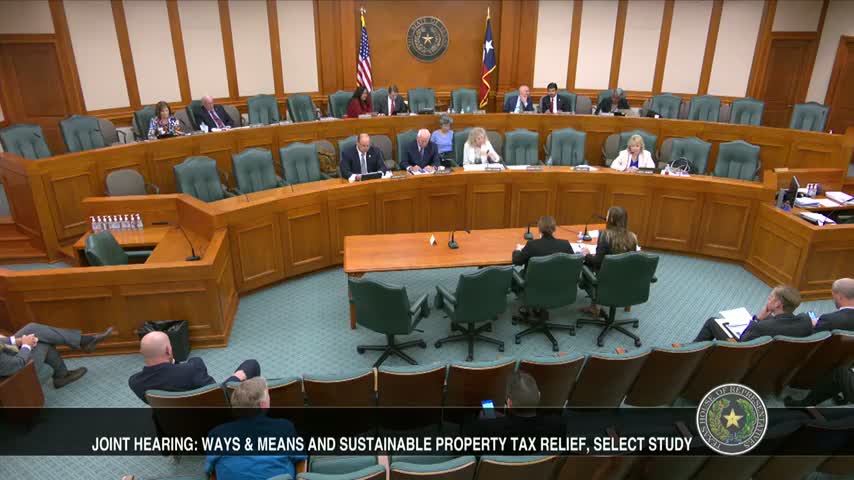Texas enacts historic property tax reform saving billions
September 26, 2024 | Committee on Ways & Means, HOUSE OF REPRESENTATIVES, Legislative, Texas
This article was created by AI summarizing key points discussed. AI makes mistakes, so for full details and context, please refer to the video of the full meeting. Please report any errors so we can fix them. Report an error »

In a recent government meeting, officials discussed significant changes to property tax structures and relief mechanisms in Texas, highlighting the impact of House Bill 3 and Senate Bill 2 on local funding and tax rates.
The meeting revealed that property tax rates in Texas are categorized into three tiers, with Tier 1 serving as the foundational level primarily influenced by student counts and characteristics. The introduction of House Bill 3 in 2019 was pivotal, as it made Tier 1 tax rates dynamic, allowing them to decrease in proportion to property value growth. This change aimed to slow the growth of property tax collections, which had previously risen alongside property values, thereby reducing the state's share of the foundation school program.
The discussion also covered the ongoing property tax relief mechanisms established by House Bill 3, which included a reduction of Tier 1 tax rates to 93 cents per $100 of property valuation and two additional relief mechanisms costing an estimated $5.3 billion for the 2024-2025 biennium. The first mechanism, known as the maximum compressed rate (MCR), adjusts tax rates based on property value growth, while the second mechanism sets a floor for tax rates to prevent excessive compression in rapidly growing districts.
Senate Bill 2 further enhanced property tax relief, reducing Tier 1 tax rates by an additional 10.7 cents and increasing the homestead exemption from $40,000 to $100,000. This legislation is projected to cost approximately $12.7 billion for the upcoming biennium, bringing the total property tax relief to an estimated $18 billion.
Glenn Hamer, president of the Texas Association of Business, praised the historic property tax reform, emphasizing its positive effects on businesses statewide. He urged continued efforts for tax relief, particularly for small businesses, and advocated for the expansion of exemptions for business personal property taxes.
Brent South, chair of the Texas Association of Appraisal Districts Legislative Committee, raised concerns about the implementation of the new homestead exemption and the 20% circuit breaker provisions in Senate Bill 2. He noted confusion among appraisal districts regarding the timing and interpretation of these changes, which could lead to inconsistent application across the state.
The meeting concluded with a commitment to address these implementation challenges and ensure clarity in property tax legislation moving forward, as officials seek to balance the needs of taxpayers with the funding requirements of local school districts.
The meeting revealed that property tax rates in Texas are categorized into three tiers, with Tier 1 serving as the foundational level primarily influenced by student counts and characteristics. The introduction of House Bill 3 in 2019 was pivotal, as it made Tier 1 tax rates dynamic, allowing them to decrease in proportion to property value growth. This change aimed to slow the growth of property tax collections, which had previously risen alongside property values, thereby reducing the state's share of the foundation school program.
The discussion also covered the ongoing property tax relief mechanisms established by House Bill 3, which included a reduction of Tier 1 tax rates to 93 cents per $100 of property valuation and two additional relief mechanisms costing an estimated $5.3 billion for the 2024-2025 biennium. The first mechanism, known as the maximum compressed rate (MCR), adjusts tax rates based on property value growth, while the second mechanism sets a floor for tax rates to prevent excessive compression in rapidly growing districts.
Senate Bill 2 further enhanced property tax relief, reducing Tier 1 tax rates by an additional 10.7 cents and increasing the homestead exemption from $40,000 to $100,000. This legislation is projected to cost approximately $12.7 billion for the upcoming biennium, bringing the total property tax relief to an estimated $18 billion.
Glenn Hamer, president of the Texas Association of Business, praised the historic property tax reform, emphasizing its positive effects on businesses statewide. He urged continued efforts for tax relief, particularly for small businesses, and advocated for the expansion of exemptions for business personal property taxes.
Brent South, chair of the Texas Association of Appraisal Districts Legislative Committee, raised concerns about the implementation of the new homestead exemption and the 20% circuit breaker provisions in Senate Bill 2. He noted confusion among appraisal districts regarding the timing and interpretation of these changes, which could lead to inconsistent application across the state.
The meeting concluded with a commitment to address these implementation challenges and ensure clarity in property tax legislation moving forward, as officials seek to balance the needs of taxpayers with the funding requirements of local school districts.
View full meeting
This article is based on a recent meeting—watch the full video and explore the complete transcript for deeper insights into the discussion.
View full meeting
